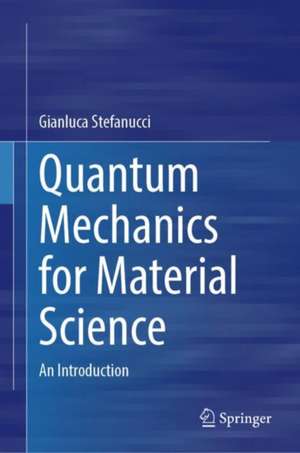Quantum Mechanics for Material Science: An Introduction
Autor Gianluca Stefanuccien Limba Engleză Hardback – 7 iun 2024
The bachelor's degree program in Materials Science aims to train students with an interdisciplinary background in physics, chemistry, and engineering. While the study of quantum mechanics is essential, the same level of depth, abstraction, and mathematical rigor as in a Physics degree program is not a requirement. Unfortunately, most textbooks on Quantum Mechanics are geared toward Physics students, making it difficult to find suitable resources for Materials Science students. To make learning easier, the author has chosen not to refer students to various textbooks for different topics. Instead, he has created handouts that have evolved into a condensed textbook on quantum mechanics specifically tailored to the needs of the Materials Science program.
Preț: 393.32 lei
Preț vechi: 485.58 lei
-19% Nou
Puncte Express: 590
Preț estimativ în valută:
75.27€ • 81.73$ • 63.23£
75.27€ • 81.73$ • 63.23£
Carte tipărită la comandă
Livrare economică 18-24 aprilie
Preluare comenzi: 021 569.72.76
Specificații
ISBN-13: 9783031601705
ISBN-10: 303160170X
Pagini: 160
Ilustrații: XI, 238 p. 19 illus., 9 illus. in color.
Dimensiuni: 155 x 235 mm
Ediția:2024
Editura: Springer Nature Switzerland
Colecția Springer
Locul publicării:Cham, Switzerland
ISBN-10: 303160170X
Pagini: 160
Ilustrații: XI, 238 p. 19 illus., 9 illus. in color.
Dimensiuni: 155 x 235 mm
Ediția:2024
Editura: Springer Nature Switzerland
Colecția Springer
Locul publicării:Cham, Switzerland
Cuprins
Chapter 1. The fundamental concepts of quantum mechanics.- Chapter 2. Quantum systems in finite-dimensional Hilbert spaces 35.- Chapter 3. A particle in one dimension.- Chapter 4. A particle in three dimensions.- Chapter 5. Spin and angular momentum composition.- Chapter 6. Approximation methods.- Appendix A: Dirac delta: definition and properties.- Appendix B: Levi-Civita tensor: definition and properties.- Appendix C: Euler range: definition and properties.
Notă biografică
Gianluca Stefanucci completed his undergraduate studies in Physics in 1998. He went on to obtain a Ph.D. in Physics and subsequently moved to Sweden, then Germany. He currently holds the position of Professor of Physics at the University of Rome Tor Vergata. His research focuses on the quantum description of matter, particularly in the areas of nanoelectronics, biomolecules, and new low-dimensional materials. He has authored over 130 publications in international scientific journals, as well as a popular science book titled "Fisica: che emozione!" (2019) and a specialized book published by Cambridge University Press titled "Nonequilibrium Many-Body Theory of Quantum Systems" (2013). Since 2017, he has been teaching Quantum Mechanics in the "Materials Sciences" degree program.
Textul de pe ultima copertă
This book is based on the course "Elements of Theoretical Physics," which the author has been teaching at the University of Rome Tor Vergata since 2017. It serves as an introduction to quantum mechanics, providing students with essential concepts and tools for future lessons, while still maintaining a comprehensive approach without relying heavily on the level of abstraction and mathematical rigor typically found in Physics programs. Understanding this book only requires knowledge of the mathematical concepts taught in the first two years of basic courses.
The bachelor's degree program in Materials Science aims to train students with an interdisciplinary background in physics, chemistry, and engineering. While the study of quantum mechanics is essential, the same level of depth, abstraction, and mathematical rigor as in a Physics degree program is not a requirement. Unfortunately, most textbooks on Quantum Mechanics are geared toward Physics students, making it difficult to find suitable resources for Materials Science students. To make learning easier, the author has chosen not to refer students to various textbooks for different topics. Instead, he has created handouts that have evolved into a condensed textbook on quantum mechanics specifically tailored to the needs of the Materials Science program.
The bachelor's degree program in Materials Science aims to train students with an interdisciplinary background in physics, chemistry, and engineering. While the study of quantum mechanics is essential, the same level of depth, abstraction, and mathematical rigor as in a Physics degree program is not a requirement. Unfortunately, most textbooks on Quantum Mechanics are geared toward Physics students, making it difficult to find suitable resources for Materials Science students. To make learning easier, the author has chosen not to refer students to various textbooks for different topics. Instead, he has created handouts that have evolved into a condensed textbook on quantum mechanics specifically tailored to the needs of the Materials Science program.
Caracteristici
Presents the results that are derived and demonstrated by guiding the reader through a series of steps Introduces quantum mechanics to students who may not be studying physics Is informal and unorthodox using physical intuition to explain concepts and results
